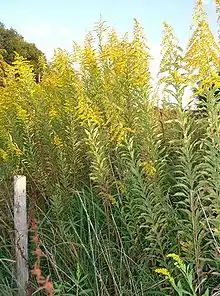Solidago altissima
Solidago altissima, the Canada goldenrod[2] or late goldenrod,[3] is a North American species of goldenrod widespread across much of Canada, the United States, and northern Mexico.[3] It is common in much of its range, and fairly tolerant of landscapes which have been disturbed by humans.[4] It has become naturalized in many parts of the world.[3][5][6]
| Solidago altissima | |
|---|---|
 | |
| Scientific classification | |
| Kingdom: | |
| (unranked): | |
| (unranked): | |
| Order: | |
| Family: | |
| Genus: | |
| Species: | S. altissima |
| Binomial name | |
| Solidago altissima | |
| Synonyms[1] | |
| |
Description
Solidago altissima is one to two meters (40-80 inches) tall, with fine hairs on the stem. The leaves are located along the stem, not in a rosette near the ground. One plant can produce as many as 1500 small yellow flower heads in a large conical array.[3]
Solidago altissima is self-incompatible, meaning that the pollen from one plant cannot pollinate the female flower parts of the same plant.[4]
Classification
Solidago altissima has diploid, tetraploid, and hexaploid populations and morphological variations which has generally led to classifying it into two subspecies, which roughly speaking can be identified as being from the eastern and western parts of the continent. At least in the Midwest, it is common to have plants of different ploidy interspersed, with little apparent tendency for one type to dominate even a fairly local geographical area.[4]
Within Solidago, S. altissima is part of the Solidago canadensis species complex, which is classified in the subsection Triplinervae.[4] S. altissima has sometimes been classified as part of S. canadensis.[3]
- Solidago altissima subsp. altissima: This is the autonym subspecies. It is in eastern Canada except Newfoundland and Labrador, and it is in the provinces of Saskatchewan and Manitoba.[8] In the United States, it is east of the Mississippi River except Wisconsin, Illinois, and North Carolina; all U.S. states directly on the west of the Mississippi River; and, Nebraska, Kansas, Oklahoma, Texas, Utah, Arizona, and California.[8] In Mexico, it is in the north except on the Baja California Peninsula, Sonora, and Sinaloa.[8] It is in all other states as far south as Oaxaca and Veracruz except Mexico, Morelos, Puebla, Tlaxcala, and Mexico City.[8] It is native in all of the above states and provinces where it resides.[8] It is an introduced species in East China, South Central China, Korea, New South Wales, Taiwan, and Transcaucasus.[8]
- Solidago altissima subsp. gilvocanescens (Rydb.) Semple: This subspecies is in western Canada and Ontario.[9] In the United States, it is only east of the Mississippi River in Illinois, and is then distributed west through the Great Plains states.[9] In Mexico, it overlaps subsp. altissima except in the west.[9]
References
- The Plant List, Solidago altissima L.
- "Solidago altissima". Natural Resources Conservation Service PLANTS Database. USDA. Retrieved 18 November 2015.
- "57. Solidago altissima Linnaeus", Flora of North America
- Kristy Halverson; Stephen B. Heard; John D. Nason & John O. Stireman III (2008), "Origins, distribution, and local co-occurrence of polyploid cytotypes in Solidago altissima (Asteraceae)", American Journal of Botany, 95 (1): 50–58, doi:10.3732/ajb.95.1.50, PMID 21632314
- Flora of China, Solidago altissima Linnaeus, 1753. 高大一枝黄花 gao da yi zhi huang hua
- Atlas of Living Australia
- "Solidago altissima L." Royal Botanic Gardens, Kew. 2017. Retrieved 27 October 2020.
- "Solidago altissima subsp. altissima". Royal Botanic Gardens, Kew. 2017. Retrieved 27 October 2020.
- "Solidago altissima subsp. gilvocanescens (Rydb.) Semple". Royal Botanic Gardens, Kew. 2017. Retrieved 27 October 2020.

